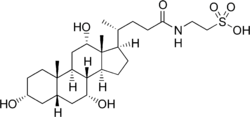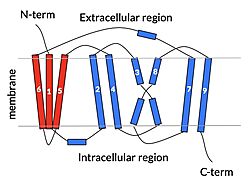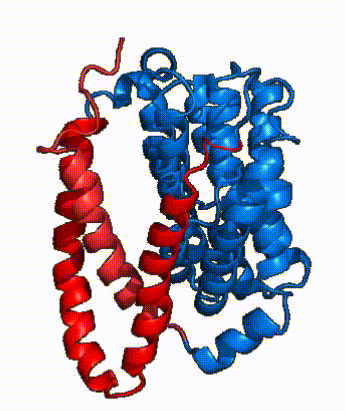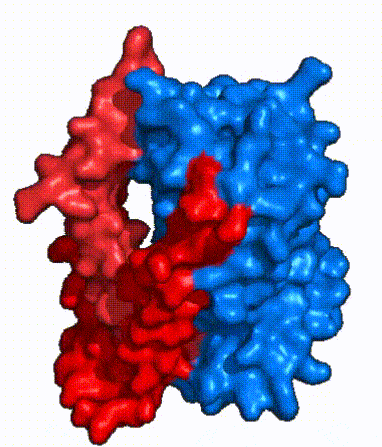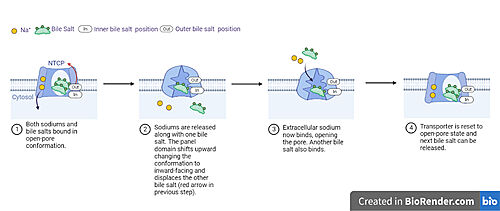Sandbox Reserved 1794
From Proteopedia
(Difference between revisions)
| Line 44: | Line 44: | ||
A proposed pathway for NTCP bile salt transport starting and ending with open-pore states hypothesizes that both sodium ions are translocated with the transport of one bile salt.<Ref name = "Liu"> Liu, H., Irobalieva, R.N., Bang-Sørensen, R. et al. Structure of human NTCP reveals the basis of recognition and sodium-driven transport of bile salts into the liver. Cell Res 32, 773–776 (2022). https://doi.org/10.1038/s41422-022-00680-4 </Ref>. Only one taurocholate is transported at a time due to NTCP's two bile salt binding sites. An | A proposed pathway for NTCP bile salt transport starting and ending with open-pore states hypothesizes that both sodium ions are translocated with the transport of one bile salt.<Ref name = "Liu"> Liu, H., Irobalieva, R.N., Bang-Sørensen, R. et al. Structure of human NTCP reveals the basis of recognition and sodium-driven transport of bile salts into the liver. Cell Res 32, 773–776 (2022). https://doi.org/10.1038/s41422-022-00680-4 </Ref>. Only one taurocholate is transported at a time due to NTCP's two bile salt binding sites. An | ||
| - | <scene name='95/952721/Inner_bile_salt/2'>inner bile salt</scene> that is closer to the cytoplasmic side of the membrane and an <scene name='95/952721/Outer_bile_salt/2'>outer bile salt</scene> that is closer to the extracellular side of the membrane <Ref name = "Liu"/> In the open-pore state both <scene name='95/952721/Mech_step_1/1'>taurocholates and sodium ions bound.</scene> Next both sodium ions are released into the cytoplasm along with the inner bile salt into the cytoplasm (Fig. 5). Once the sodium ions are released this will trigger the conformational change in NTCP. The <scene name='95/952721/Mech_step_2/2'>outermost bile salt remains bound</scene> in the pore, likely helping to prevent leakage. <Ref name = "Liu"/> Then the <scene name='95/ | + | <scene name='95/952721/Inner_bile_salt/2'>inner bile salt</scene> that is closer to the cytoplasmic side of the membrane and an <scene name='95/952721/Outer_bile_salt/2'>outer bile salt</scene> that is closer to the extracellular side of the membrane <Ref name = "Liu"/> In the open-pore state both <scene name='95/952721/Mech_step_1/1'>taurocholates and sodium ions bound.</scene> Next both sodium ions are released into the cytoplasm along with the inner bile salt into the cytoplasm (Fig. 5). Once the sodium ions are released this will trigger the conformational change in NTCP. The <scene name='95/952721/Mech_step_2/2'>outermost bile salt remains bound</scene> in the pore, likely helping to prevent leakage. <Ref name = "Liu"/> Then the <scene name='95/952722/Mech_step_3/1'>outer bile salt is displaced</scene> into the inner bile salt binding site by the movement from conformational change to the inward-facing, pore inaccessible state due to sodium ion release (Fig. 5). <Ref name = "Liu"/> Two new sodium ions then bind to NTCP from the extracellular side, favoring the open-pore state and also allowing for the binding of another outer bile salt (Fig 5). The <scene name='95/952721/Mech_step_1/1'>protein is then reset</scene> and the process can then start again releasing the next inner bile salt with the translocation of the sodium ions into the cytoplasm. This mechanism melds typical patterns of [https://proteopedia.org/wiki/index.php/Pump gated channels and pumps] in a new light as sodium ions control conformation and thus binding, displacement, and release of bile salts. <Ref name = "Goutam"/> |
== HBV Binding and Infection== | == HBV Binding and Infection== | ||
Revision as of 21:35, 20 April 2023
Sodium Taurocholate Co-Transporting Polypeptide
| |||||||||||
References
- ↑ Stieger B. The role of the sodium-taurocholate cotransporting polypeptide (NTCP) and of the bile salt export pump (BSEP) in physiology and pathophysiology of bile formation. Handb Exp Pharmacol. 2011;(201):205-59. doi: 10.1007/978-3-642-14541-4_5. PMID: 21103971. DOI: DOI: 10.1007/978-3-642-14541-4_5.
- ↑ Geyer, J., Wilke, T. & Petzinger, E. The solute carrier family SLC10: more than a family of bile acid transporters regarding function and phylogenetic relationships. Naunyn Schmied Arch Pharmacol 372, 413–431 (2006). https://doi.org/10.1007/s00210-006-0043-8
- ↑ 3.0 3.1 3.2 3.3 3.4 3.5 3.6 3.7 3.8 3.9 Goutam, K., Ielasi, F.S., Pardon, E. et al. Structural basis of sodium-dependent bile salt uptake into the liver. Nature 606, 1015–1020 (2022). DOI: 10.1038/s41586-022-04723-z.
- ↑ 4.0 4.1 4.2 4.3 4.4 Park, JH., Iwamoto, M., Yun, JH. et al. Structural insights into the HBV receptor and bile acid transporter NTCP. Nature 606, 1027–1031 (2022). https://doi.org/10.1038/s41586-022-04857-0.
- ↑ 5.0 5.1 5.2 5.3 5.4 Liu, H., Irobalieva, R.N., Bang-Sørensen, R. et al. Structure of human NTCP reveals the basis of recognition and sodium-driven transport of bile salts into the liver. Cell Res 32, 773–776 (2022). https://doi.org/10.1038/s41422-022-00680-4
- ↑ Qi X. and Li W. (2022). Unlocking the secrets to human NTCP structure. The Innovation 3(5), 100294. https://doi.org/10.1016/j.xinn.2022.100294
- ↑ Latorraca, N. R.; Fastman, N. M.; Venkatakrishnan, A. J.; Frommer, W. B.; Dror, R. O.; Feng, L. Mechanism of Substrate Translocation in an Alternating Access Transporter. Cell 2017, 169 (1), 96–107.
- ↑ 8.0 8.1 8.2 8.3 Asami, J., Kimura, K.T., Fujita-Fujiharu, Y. et al.Structure of the bile acid transporter and HBV receptor NTCP. Nature 606, 1021–1026 (2022). https://doi.org/10.1038/s41586-022-04845-4
- ↑ Grove, J.; Marsh, M. The Cell Biology of Receptor-Mediated Virus Entry. Journal of Cell Biology 2011, 195 (7), 1071–1082.
- ↑ 10.0 10.1 Herrscher C, Roingeard P, Blanchard E. Hepatitis B Virus Entry into Cells. Cells. 2020 Jun 18;9(6):1486. doi: 10.3390/cells9061486. PMID: 32570893; PMCID: PMC7349259.
Student Contributors
- Isabelle White
- Lena Barko
